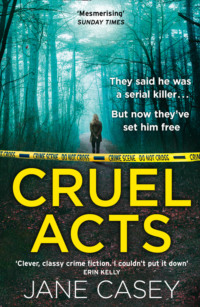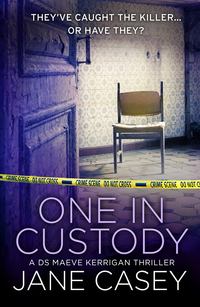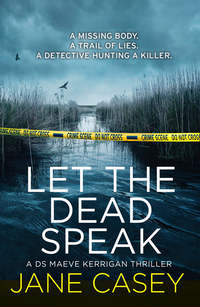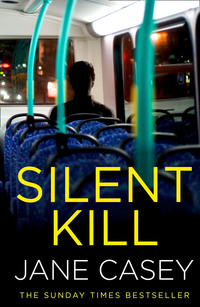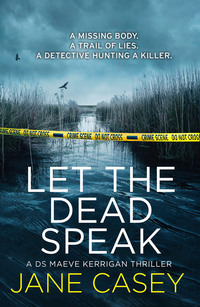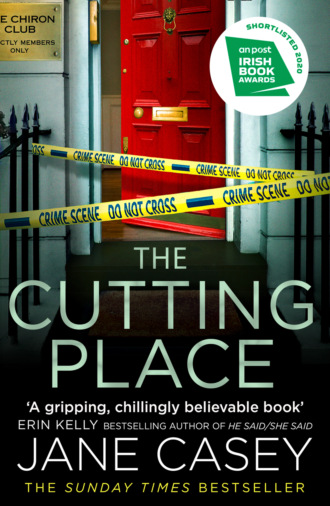
Полная версия

THE CUTTING PLACE
Jane Casey

Copyright
Published by HarperCollinsPublishers Ltd
1 London Bridge Street
London SE1 9GF
www.harpercollins.co.uk
First published in Great Britain by HarperCollinsPublishers Ltd 2020
Copyright © Jane Casey 2020
Cover design by Claire Ward © HarperCollinsPublishers Ltd 2020
Cover photographs © Mark Owen / Trevillion Images (woman in tunnel), Shutterstock.com (all other images)
Excerpt from The Killing Kind © Jane Casey 2021
Jane Casey asserts the moral right to be identified as the author of this work.
A catalogue copy of this book is available from the British Library.
This novel is entirely a work of fiction. The names, characters and incidents portrayed in it are the work of the author’s imagination. Any resemblance to actual persons, living or dead, events or localities is entirely coincidental.
All rights reserved under International and Pan-American Copyright Conventions. By payment of the required fees, you have been granted the non-exclusive, non-transferable right to access and read the text of this e-book on screen. No part of this text may be reproduced, transmitted, down-loaded, decompiled, reverse engineered, or stored in or introduced into any information storage and retrieval system, in any form or by any means, whether electronic or mechanical, now known or hereinafter invented, without the express written permission of HarperCollins.
Source ISBN: 9780008149086
Ebook Edition © April 2020 ISBN: 9780008149109
Version: 2021-03-24
Dedication
For Claire Graham
Epigraph
‘Ask yourself “Am I satisfied that I have done all I can?”’
from the Domestic Abuse, Stalking and Harassment and Honour Based Violence (DASH 2009)
Risk Identification and Assessment Checklist for Police Staff Laura Richards, BSc, Msc, FRSA
Contents
Cover
Title Page
Copyright
Dedication
Epigraph
Chapter 1
Chapter 2
Chapter 3
Two years earlier
Chapter 4
Chapter 5
Chapter 6
Two years earlier
Chapter 7
Chapter 8
Two years earlier
Chapter 9
Chapter 10
Two years earlier
Chapter 11
Chapter 12
Two years earlier
Chapter 13
Chapter 14
Chapter 15
Chapter 16
Two years earlier
Chapter 17
Two years earlier
Chapter 18
Chapter 19
Now
Chapter 20
Chapter 21
Chapter 22
Chapter 23
Chapter 24
Now
Chapter 25
Chapter 26
Chapter 27
Chapter 28
Chapter 29
Chapter 30
Chapter 31
Chapter 32
Chapter 33
Chapter 34
Chapter 35
Chapter 36
Chapter 37
Chapter 38
Chapter 39
Chapter 40
Chapter 41
Chapter 42
Chapter 43
Chapter 44
Chapter 45
Chapter 46
Chapter 47
Chapter 48
Keep Reading …
Acknowledgements
About the Author
Also by Jane Casey
About the Publisher
1
For a few moments, it was the quietest place in London. The area under the footbridge was as hushed as a chapel while the black mortuary van was pulling away. A little group of us had gathered there to show our respects, photograph-still: uniformed officers, forensic investigators, a team from the Marine Police unit in their wetsuits, a pair of detectives and a small grey-haired woman in waterproofs and rubber boots standing to one side, her arms folded. Then the van disappeared from view and the picture dissolved into movement. Back to work. Life goes on.
The woman in waterproofs turned to me.
‘Is that it, then? Can I go?’
‘Not yet, if you don’t mind. I need to hear your account of what happened.’
Kim Weldon gave a deep, testy sigh. ‘I’ve been here for hours. I’ve told you everything I know already.’
She hadn’t told me, because I’d only been there for a few minutes, but I decided not to point that out. I was used to arriving at a crime scene last of all, the detective sergeant coming in with a notebook and a pen and an endless list of questions when everyone just wanted to go home. ‘I know it’s frustrating, Mrs Weldon, but we’ll try not to keep you for much longer. Do you need to let someone know you’re running late?’
She shook her head. ‘I live alone since my husband died. No one’s waiting for me. But I got here at five this morning and I’m tired.’
‘Early start.’ The comment came from over my shoulder, where DI Josh Derwent had apparently decided to take an interest in the conversation. ‘That’s keen.’
‘Of course. It’s the best time to be here. Before all of … this.’ She gestured at the footbridge over our heads, where the tide of commuters heading to work in the City formed a second river, flowing as ceaselessly as the Thames towards the great dome of St Paul’s. ‘It’s so busy now. I can’t even think.’
It seemed quiet enough to me, but Derwent nodded. ‘Let’s find somewhere more peaceful where we can talk. A café, or—’
‘The best place to talk around here is down there.’ She gestured over the wall to the foreshore, a strip of shingle a few metres wide that extended to the left and right along the river bank. ‘I can show you where I was. Easier than having to describe it all.’
‘How do we get down there?’ I asked.
‘There are steps.’ She set off towards them, moving briskly, and we followed her obediently. ‘But you’ll have to come down one at a time and mind how you go. It’s steep and it gets slippery.’
The steps were concrete and more like a ladder than stairs. The treads were so narrow I had to step sideways, juggling my bag and clipboard awkwardly, off balance. My long coat threatened to trip me up at every step. Kim Weldon was short and had a low centre of gravity, unlike me, so that explained why she had found it easy. On the other hand, Derwent was taller than me – just – and he had rattled down in no time, as light on his feet as a boxer despite his broad-shouldered build. He stood at the foot of the thirty or so steps and watched my progress, which didn’t help.
‘You could come down backwards.’
‘This is fine.’
‘Do you need a hand?’
‘I can manage.’
‘Only we all have other places to be.’
‘I know,’ I said through gritted teeth, concentrating on placing my feet carefully. The shingle below shimmered in the morning light, out of focus and dizzy-making.
‘Like a cat coming down a tree. I can call the fire brigade out to rescue you if you like. It’s not as if Trumpton have anything better to do.’
‘I’m fine,’ I snapped, and ignored the hand he reached up to help me down the last few steps. He stuck it back in his coat pocket with a grin that I also ignored as I made it to the shingle at last. Kim Weldon was watching us with interest. Considering I spent so much time assessing witnesses it shouldn’t have surprised me to remember it was a two-way process. I tried to see us as she might: officialdom in dark trouser-suits and polished shoes, Derwent’s hair cropped close to his head in a way that hinted at a military background, broodingly handsome. I was younger than him as well as junior in rank and aimed to be as neat, though my hair was already beginning to spiral free from the bun I’d trapped it in. We stepped around each other with the practised ease of longstanding dance partners. As a rule, Derwent was rude enough to me that even people who knew us well suspected we were sleeping together, or hated each other, or both. The truth was that we’d never slept together, and I only hated him from time to time. We were closer than most colleagues, it was fair to say – friends, after all we’d been through together. There was also the fact that he was my landlord. I currently lived in a one-bedroom flat he owned, though I fully intended to look for somewhere else to live. I just hadn’t got around to it yet. We bickered like children and trusted each other’s instincts without even thinking about it.
No wonder Mrs Weldon looked puzzled.
‘Where do we need to go?’ I asked her.
‘Along here.’ She gestured to the left of the bridge. ‘That’s the way I went this morning. I came down the steps around five, as I said. Sunrise is about half past five at this time of year but it was starting to get light. I could see well enough without a head torch.’
‘Do you do this often?’ Derwent asked.
‘Most days.’ She smiled, looking out across the river and breathing deeply. The air was fresh down by the water, and the hum of the city seemed to recede. Seagulls hovered overhead, peevish and mocking as they floated on the cool spring breeze. ‘This is my place. I’m a licensed mudlarker. I take what the river chooses to give me, whether it’s treasure or trash.’
‘Treasure?’ Derwent scuffed the shingle with the toe of his shoe. ‘What kind of treasure?’
‘Nothing valuable, exactly. But items of historical interest. And sometimes the trash is interesting too.’ She bent and picked up a small white tube. ‘What do you think this is?’
I peered at it. ‘A bit of china?’
‘It’s the stem of a clay pipe. I can’t date this without having the bowl, and the bowls are harder to find, but it could be from the 1600s. The pipes were in common use up to Victorian times. When they broke, they couldn’t be repaired and people would chuck them into the river.’
‘An antique fag end.’
She looked at Derwent sharply, her eyes bright. ‘You don’t see the appeal, Inspector. But that’s a little piece of London’s history. The man or woman who smoked it is long gone and forgotten, but we know they were here. I might be the first person to touch it since they flung it in the water.’
‘What sort of things do you find?’ I asked.
‘I’ve found Roman glass once or twice, and coins, and bits of pottery. Last year I found a medieval die made out of bone. How did it end up here? Maybe someone flicked it into the river because they’d had a run of bad luck, or maybe they stumbled as they boarded a skiff to cross to the other bank and it fell out of their pocket. There are a hundred possibilities, a hundred stories in one small scrap of history. My favourite was a bone hairpin that was a thousand years old. That’s in the Museum of London, now, with my name recorded as the person who found it. That pin will still be there long after I’m gone too.’
‘And people will know you were here,’ I said.
The fan of wrinkles around her eyes deepened as she grinned. ‘Everybody wants to leave a trace of themselves behind, after all – some evidence they walked the earth. One day someone might be grateful I was in the right place at the right time to find something special. That keeps me coming back.’
‘So what was different about this morning?’ I asked.
‘Nothing. Everything was the same as usual. At least it was until I found it. Then everything went sideways.’ A low chuckle. Kim Weldon struck me as the kind of person who didn’t allow herself to be unsettled by anything; if what she had found upset her, she had got over it by now.
But I noticed she said ‘it’, rather than what she had found.
‘Where were you when you saw it?’
She pointed. ‘See the white stripe on the wall? I was halfway between here and there. I always give myself a marker to reach because it’s too easy to get distracted and forget to keep an eye on the tide. You can get caught out – never happens to me but I’ve seen other people get soaked. So I always give myself a limited search area and then I go once I’ve covered it.’
A Thames Clipper barrelled past, ferrying commuters up the river, and the wake sent a wave that splashed over one of Derwent’s shoes. He stepped back quickly, swearing under his breath, shaking his foot.
‘It’s all right, the water is quite clean these days. They’ve even found seahorses down the river, near Greenwich, so it’s fresh. But you really need boots like mine, and you need to be more respectful of the river.’ She looked wistful. ‘I’ve seen grown men tipped over by a wave like that.’
‘I’ll bear it in mind.’ From his tone of voice, I strongly suspected that he wouldn’t be returning to the foreshore any time soon if he could help it, boots or no boots.
‘This way.’ The slight, upright figure crunched away from us to where a wooden post stuck out of the shingle, frayed with age and the action of the water. ‘They used to tie up barges here.’ She pointed at the sandy edge of the river. ‘This is where it was.’
It.
‘And it was just lying there?’ I checked.
She looked baffled. ‘What else would it be doing?’
‘No, I meant – it wasn’t buried, or wrapped in anything?’
‘No, no. It was lying there on the shingle. I thought it was a tree root at first – you do get them washed down the river from upstream where the banks are overgrown. I was going to take a picture of it to put on my Facebook page, because it looked like a hand. But then, when I got a bit closer, I thought it looked a bit too much like a hand. And then, of course …’ She shrugged. ‘It was a hand.’
‘Did you touch it?’ Derwent asked.
‘Before I knew what it was. I turned it over. It was palm down, with the fingers curled under it, you see.’ She held up her own hand to demonstrate, a loose fist with knuckles to the sky. ‘Then when I felt it, I knew it couldn’t be a root. Too soft. Too much give in it. But it wasn’t until I saw the fingernails that I was sure. It was such a strange thing to find that I couldn’t quite admit to myself what it was. I took some pictures of it and where I found it and then I picked it up. I was afraid it would be washed away before anyone came to recover it.’
‘You must have had a shock,’ I said.
‘Well, you expect to find bones here – this was London’s rubbish dump for thousands of years, and this area in particular was full of markets. But the bones tend to belong to sheep or pigs or cows. Sometimes you find a bit of a fox. I’ve never found a hand before.’ She faced into the breeze and smiled. ‘But then you never do know what the river will give you.’
At the top of the stairs, the Marine Unit were packing up to head back to their base at Wapping.
‘Finished for the day, lads?’ Derwent demanded as they went past us.
The sergeant stopped. He was mid-fifties and serious. ‘Tide’s coming in. We’re not going to find anything else here today.’
They had found three other pieces of tattered bone and flesh that had all been carefully preserved in coolers for transportation to the mortuary along with the hand. Thinking of what Kim Weldon had said about animal remains, I asked, ‘Are you sure that what you found is human?’
‘No idea.’ He heaved a bag onto his back. ‘But the pathologist will tell you if it’s not.’
‘Where’s the rest of the body?’ Derwent asked. ‘In the sea?’
‘Could be. Could be we’ll find some more bits in the next few days. We’ll be looking. Where we find things has a lot to do with the tide and the shape of the river. The way the water moves through it depends on whether the banks are concave or convex. You get lots of stuff washing up around Greenwich, for instance, and at Wapping, and at Tower Bridge. You won’t find as much on the opposite banks. So we have a few places to look.’
‘I never really thought about the tide coming up the river,’ I said. ‘I thought it flowed out to the sea and that was it.’
He shook his head, not even trying to hide his scorn. ‘Why do you think the flood barrier exists? There’s a clue in the name, love.’
‘I’m not saying I couldn’t have worked it out,’ I protested. ‘I’ve never thought about it before.’
He grunted. Clearly I was worth even less of his time now, which was a shame because I needed his expert knowledge.
I tucked a stray curl of hair behind my ear, widening my eyes to play up the helpless look. ‘As you can tell, I don’t know much about this. The river flows in both directions, so does that mean we can’t tell where the body parts might have gone in? Could they have been moved up here by the action of the tide?’
He wrinkled his forehead, considering it. ‘The tide moves things up but then it moves them back again on the way out, if you see what I mean. That makes it hard to pinpoint where items enter the water. They sometimes wash around the same area for a while.’
‘Could they have been dumped off a boat?’ Derwent asked.
‘Yeah. But why draw attention to yourself by hopping in a boat to dump body parts when you could slip them into the river from the shore? No one would have noticed if it was small parts, which is what we’ve found. People don’t realise but the river is a busy place. You wouldn’t want to be out there midstream and not know what you’re doing.’
He was right. I’d never realised how busy the Thames was with constant boat traffic: commuter boats, tours, barges loaded with building materials, small speedboats and larger vessels crewed by competent-looking people in high-vis overalls.
‘If the body parts turned up in this area, does this mean they were all thrown in the river here?’
‘I wouldn’t want to try to guess, love. But we only found four pieces. Better hope there’s more to come.’ He nodded briskly and strode away.
‘Thanks for the help,’ I called after him.
‘I don’t know much about this,’ Derwent cooed in my ear. ‘Please explain it to me, Mr Police Diver.’
‘And did he explain it to me?’
‘Sort of.’
‘So it worked.’ I put my notebook away. ‘But don’t get used to it.’
2
‘Hello, you two.’ The pathologist Dr Early barely looked up as we walked in; at the best of times she was a fast-moving blur in scrubs, humming with nervous energy, and she didn’t waste precious seconds on elaborate greetings. ‘I was wondering who was going to be lucky enough to get this one.’
‘Nothing like a nice easy case to start the week,’ I said.
‘And this is nothing like an easy case.’ Dr Early gathered an armful of files and headed for the door.
‘I was going to say that.’ Derwent was actually sulking as we followed the pathologist through the security doors that led to the morgue.
One of her assistants was photographing a collection of objects that lay on a metal table under the glare of a bright light. He was heavily built but he moved with precision and focus as he skirted the table.
‘Here we are.’ Dr Early slipped a pair of gloves on and pulled her mask up over her mouth and nose. ‘You need protective kit too. Then it’s jigsaw puzzle time.’
‘I’m not a doctor, but it looks as if you’re missing a few pieces,’ Derwent said before he tied his mask on.
‘And I’m not a detective but it looks as if it’s your job to find them.’ Dr Early raised her eyebrows at him meaningfully and I smirked to myself under the cover of my own mask: victory to the pathologist.
None of us had forgotten where we were or what lay on the table beside us, but banter was one of the only ways to feel normal when your job involved looking closely at fragments of a human being. Not that I would have known what I was looking at, if I hadn’t been told. No piece was bigger than a shoebox. The skin was yellowed, bleached by the river, and the flesh underneath it was pale and ragged, bloodless. White bone gleamed under the bright lights that shone on the table.
‘So. What we’ve got are four pieces of what seems to be an adult female. She was probably IC1, probably light-haired and probably younger rather than older, but I’m not putting most of that in my initial report because it’s an educated guess at the moment – it’s purely for your benefit.’
‘Why do you say it was a woman?’ I asked.
‘I’m going on the size of the hand and the joints that we’ve recovered – they would be average for an adult female. The muscle development and fat ratio suggests a reasonably fit, relatively young woman. The body hair was removed from the legs at the root – waxed, epilated, something like that. She had very fine light brown body hair on her hand and shoulder. And the fingernails were painted at some stage because I can see tiny traces of dark polish around the cuticles. It is still possible that it was a man, but I think it more likely we’re looking at a woman. No tattoos, no scars, no distinguishing marks so far.’
‘Any idea when she died?’ Derwent asked.
‘I’d guess she’s been in the water for a couple of days. Do you want me to talk you through her piece by piece?’
‘No, but you probably should.’ Even with the mask obscuring most of his face, I could tell Derwent wasn’t enjoying himself.
Dr Early pointed. ‘This is an easy one. It’s a right hand.’
‘That’s what our mudlarker found.’ I leaned in to see it, trying to imagine how it might have looked on the shingle. ‘She didn’t know what it was at first.’
‘It’s out of context, isn’t it? We don’t expect to see something like that without the rest of the body to go with it.’
‘What other bits have we got?’ Derwent was peering at the three other pieces of flesh on the table. The way they were laid out reminded me of a butcher’s window.
‘We have one part of a thigh, one part of a lower leg and a left shoulder joint. We won’t get all of her but it would be very helpful if your lot could track down a few more pieces. Currently this doesn’t tell me very much at all. The rest of the torso would be a great help. And the head would be the best thing of all to find, if we’re going to identify her. Unless her DNA is in the database, of course. Then it’ll be straightforward. I’ve submitted a sample already so cross your fingers.’
‘Is there anything to suggest how she died?’ I asked.
‘Not so far. All I can tell you is that she was already dead when she was cut up.’
‘That’s something,’ I said, and the pathologist nodded.
‘They did a very thorough job on her, I have to say.’
‘Was she cut up deliberately? Could it have been an accident? A propeller, something like that?’ Derwent asked.
‘Definitely not a propeller.’ Dr Early turned one of the leg pieces so we could see the end of the bone. ‘When you cut into a bone like this, the marks you leave are called kerfs and they can tell us a huge amount of information about the instrument that made the cut. See this notch here, about a centimetre from the end? It’s a false-start kerf, where whoever dismembered her started cutting into the bone, stopped, and moved down to begin a new kerf. Second time, he managed to cut through the fibia. The first cut is precisely parallel to the second. He didn’t move between the two attempts and her body wasn’t moving as it would have been if the cuts had been made in water by something like a boat’s propeller. This was deliberate dismemberment, not an accident.’


